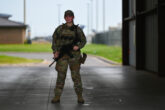August 08, 2024
Preparing for the Possibility of a Draft without Panic
This article was originally published in War on the Rocks.
Conscription — a practice most Americans believe should be relegated to the dustbin of history — has returned as an uncomfortable topic of conversation among U.S. allies and adversaries alike. This has generated concern and even conspiracy theories among American voters. But a candid discussion would be healthier. The fact is, if the United States hopes to deter or defeat a Chinese attack on Taiwan, it should be prepared to effectively implement a draft. To be clear, this is a solution of last resort, but one that may be necessary.
Right now, U.S. mobilization has not been tested in decades. As a result, current ideas about how it would function are woefully out of date. Being prepared to execute a draft requires buy-in from across all branches of government — and society writ large.
Conscription has never had a political constituency in Congress. It remains a serious, costly, and potentially deadly tool meant to protect Americans from the extreme consequences of an existential threat.
At a minimum, the executive branch and Congress should actively pursue a more proactive approach. The National Security Council should take the lead on mobilization exercises. Congress should also get out ahead on expanding Selective Service System registration to all Americans between the ages of 18–25, thereby preventing future legal challenges to the current all-male registration system when time may be of the essence. Policymakers should also consider the skills that would be required in a future conflict and how the nation would sustain its economy while maintaining the human capital required in large-scale combat operations. Finally, the professional all-volunteer force should consider and train for a possibility in which they would have to absorb conscript forces into their ranks.
Read the full article from War on the Rocks.
More from CNAS
-
National Security Human Capital Program
Could the U.S. Bring Back the Draft?In this episode of At the Boundary, GNSI’s Dr. Guido Rossi sits down with Katherine Kuzminski, Director of Studies at the Center for a New American Security (CNAS), to explore...
By Katherine L. Kuzminski
-
Defense / National Security Human Capital Program / Technology & National Security
Episode 7: The Future Hands Shaping the U.S.’s Unmanned ArsenalHow is the U.S. responding to unmanned innovation across the globe? This episode with Paul Scharre, executive vice president, Stacie Pettyjohn, program director and senior fel...
By Stacie Pettyjohn, Paul Scharre & Lt. Gen. Jack Shanahan
-
Defense / National Security Human Capital Program / Transatlantic Security / Technology & National Security
Sharper: America’s EdgeA volatile global security environment requires the United States and its allies to develop new tactics and capabilities to deal with novel global threats. On June 3, policyma...
By Charles Horn
-
National Security Human Capital Program
National Security Has a Human Capital Problem and There’s No Fast Way OutNational security doesn’t really exist without the military forces and supporting civilians to carry it out. Recruitment remains a problem for the armed forces. And there’s a ...
By Katherine L. Kuzminski




